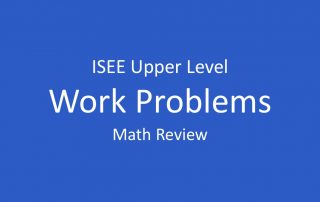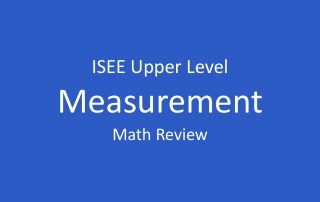About the ISEE Upper Level
 The ISEE Upper Level is the ACT of private school admissions for grades 9 through 12. Just as colleges use the SAT and ACT to determine applicant preparedness, many independent schools across the US achieve the same effect with the ISEE.
The ISEE Upper Level is the ACT of private school admissions for grades 9 through 12. Just as colleges use the SAT and ACT to determine applicant preparedness, many independent schools across the US achieve the same effect with the ISEE.
Because teachers, curriculums, and academic difficulty vary from school to school, a student’s report card is not sufficient enough to accurately compare students from different schools. Therefore they use a standardized test like the ISEE.
ISEE is an acronym that stands for the Independent School Entrance Exam. It is administered by the non-profit group ERB, Educational Records Bureau. You’ve probably heard of ERB before in the context of annual testing, particularly if your school administers the CTP-4, which is somewhat similar to the ISEE.
ISEE Upper Level Research, Analysis, & Adice
ISEE Math Review – Operations on Algebraic Expressions
In a nutshell, Algebra is arithmetic using known and unknown quantities. These unknown quantities are called variables and are represented as a letter (x) or a symbol. You have already evaluated some algebraic expressions by substituting certain values for some or all of the variables within the expression. Now, let’s apply what we know about basic mathematical operations to algebraic expressions without substituting values for the variables. Certain operations can [...]
ISEE Math Review – Matrix Multiplication, Standard Deviation, and Trigonometry
The Upper Level ISEE is used for application into 9th through 12th grade. Thus, the ISEE sometimes includes some higher level math concepts designed for students who have completed Algebra II or Pre‐Calculus. We have included three of these concepts so that you know what they look like so you can determine for yourself whether or not you should spend any time trying to solve them. While it is good [...]
ISEE Math Review – Polygons: Angles, Perimeter, and Area
Polygons are two‐dimensional shapes that are formed by three or more straight sides. You will be analyzing these geometric figures to find the total degree value of a polygon, the perimeter of a polygon, and the area of a polygon. The perimeter is the measurement of the sum of the side lengths of a polygon. The area is the measurement of the inner portion of the polygon. *Apothem is perpendicularly [...]
ISEE Math Review – Work Word Problems
Like rate, time, and distance questions, work word problems are interested in how long it will take individuals, or workers, to complete a project alone or as a group. The idea here is that it takes a worker a certain amount of time to complete a job. If another worker joins his or her efforts, the job will (theoretically) be completed in less time. The rate of the workers, or [...]
ISEE Math Review – Solid Geometry: Surface Area and Volume
Triangles, polygons, and circles are all considered two‐dimensional objects, and you’ve learned how to find the perimeter and area of these objects. You will also need to know how to analyze the measurements of their three‐dimensional counterparts, or solid geometry. For solid geometry, you will need to know the volume and the surface area of a three‐dimensional object. The surface area of a solid figure is like the perimeter of [...]
ISEE Math Review – Units of Measurement
The United States uses what is known as the U.S. Customary Units, a variation of the Imperial system, for its measurement values. Most of the rest of the world uses the International System of Units, the modern iteration of the Metric system. The ERB will likely provide some conversions and values for U.S. Customary Units measurements, but you are expected to know conversions for International System of Units measurements. You [...]








